The hike to Ausangate Mountain is one of the least explored routes, but it is deeply authentic. Discover the combination of stunning Andean landscapes with a unique cultural immersion. This journey is ideal for adventurers seeking an intimate connection with nature and spirituality wishing to experience life in Andean communities.
We will visit the communities of the village of Pinchimuro in the district of Ocongate (Quispicanchi), located in the department of Cusco, Peru. We will participate in a two-day cultural trek, living a transformative, welcoming, and enriching experience. Do you know what community tourism is in this country?
What is community tourism?
Community or experiential tourism is a form of travel that places local communities at the center of the tourist experience. It prioritizes cultural preservation, sustainability, and the empowerment of the people living in the visited destinations.
In Cusco, this type of tourism allows visitors to interact directly with Andean communities’ customs, traditions, and ways of life, contributing directly to their economy and fostering enriching cultural exchanges.
Key Features of Community Tourism:
- Cultural immersion: Visitors participate in everyday activities such as farming, animal husbandry, preparing traditional meals, weaving, and crafting.
- Natural landscapes: Excursions offer stunning views of the Andes’ mountains and valleys. Many activities are connected with respect for and harmony with nature.
- Spiritual traditions: Residents share ancestral practices such as offerings to Pachamama (Mother Earth) and other Andean rituals.
- Local lodging and cuisine: Tourists stay in local family homes, experiencing a simple, traditional lifestyle. The cuisine features local ingredients like quinoa, potatoes, and corn.
- Educational interaction: It’s an opportunity to learn about the history, challenges, and customs of indigenous communities, promoting respect for cultural diversity.
Benefits of Community Tourism:
- For residents: Generates additional income and strengthens cultural pride, encouraging the preservation of traditions.
- For visitors: Offers a meaningful and transformative experience, distinct from conventional tourism.
- For sustainability: Promotes environmentally respectful practices and supports local cultures.
Each Andean region, with its rich cultural heritage and privileged location in the Peruvian Andes, demonstrates how experiential tourism can bridge the modern world and ancestral traditions.
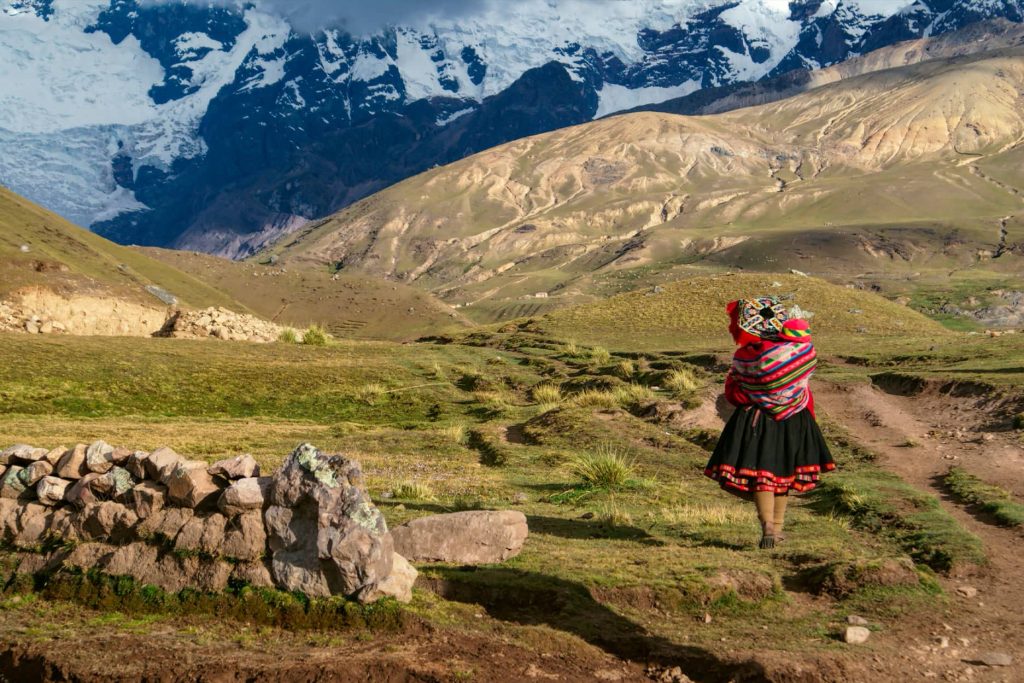
The Journey to Ausangate
We set off from Cusco to the village of Pinchimuro, located in the Ocongate district, a journey of approximately 3 to 4 hours by land, depending on road conditions and the mode of transport used. The journey itself is a spectacle, with landscapes evoking the grandeur and serenity of the Andes.
The roads wind between valleys and mountains. Andean mist dances at dawn, and the wind whispers ancient tales. Every turn reveals a divine painting, with snow-capped peaks reaching the heavens and silver rivers flowing like sacred tears, nourishing the land where life flourishes.
Sleepy villages nestle in the valleys, guarding secrets in their ancient stones. Fields of quinoa and potatoes form vibrant mosaics, bearing witness to the hard work of Andean hands.
The road stretches ahead, blending green and gold, as the horizon warmly embraces the traveler.
In the distance appears Pinchimuro, a sanctuary where time moves slowly. Pachamama is quietly revered here, and the starry sky shares stories with those who listen.
Traveling through the Andean communities is not just about landscapes; it’s a return to the soul, essence, and simplicity. From Cusco to Pinchimuro, it’s a moving poem written in the veins of the mountains and the traveler’s heart.
Pinchimuro, with its cultural richness and natural beauty, is one of Peru’s hidden treasures, offering visitors the chance to experience the country in its purest form, far from conventional tourism and in harmony with the Andean spirit.

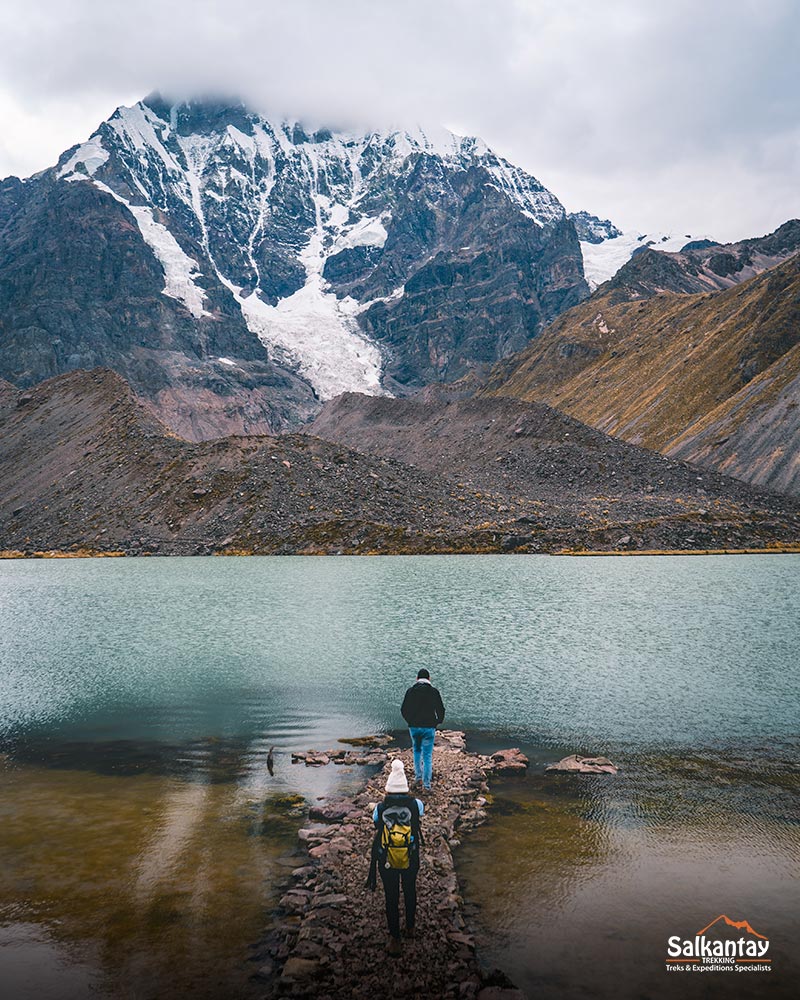
Details of the Route to Pinchimuro:
- Distance: Approximately 100 km, with paved roads (to Ocongate) and possibly unpaved or less developed paths near Pinchimuro.
- Main route: Follow the Interoceanic Highway South (PE-28A) to Ocongate, then continue on local roads to Pinchimuro.
- Transportation options:
- Private car or taxi: About three hours.
- Public transport (buses or vans): Up to 4 hours or more, depending on stops.
Day 1: Arrival in Pinchimuro
The experience in the homes of residents in the communities at the base of Ausangate is deeply immersive and enriching, offering visitors an intimate connection with Andean traditions and the majestic nature of the Andes.
Upon arriving in Pinchimuro, local hosts, often dressed in colorful traditional attire, greet you with a warm smile. The aroma of muña tea (an Andean medicinal herb) or coca tea invites you to relax after your journey.
- Welcome: Locals perform small welcome rituals, Andean dances, and songs, or simple offerings to Pachamama in gratitude for the arrival of a new friend.
- Accommodation: The houses, built with local materials like adobe and straw roofs, are simple yet welcoming. Every detail reflects the Andean way of life, and visitors integrate into the family routine.
- Typical dishes: Enjoy traditional breakfasts, lunches, and dinners made with fresh, daily-harvested ingredients. The trout served is delicious, a product of the excellent work in the region’s fish farms.
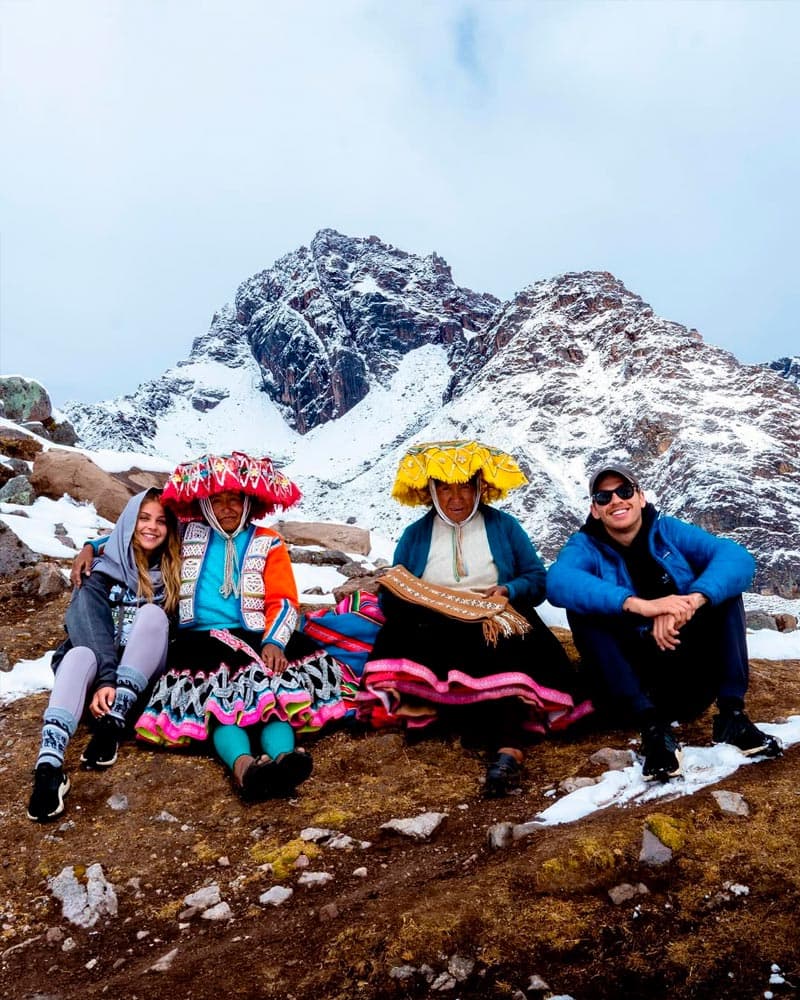
Cultural Activities
After settling in, you’ll embark on the region’s cultural activities. You’ll visit the fish farms, where you’ll have the chance to fish and enjoy the fruits of your labor for lunch. In the afternoon, take a pleasant and relaxing walk to Coricocha Lagoon, where you’ll encounter native flora and fauna while listening to local legends.
Fish Farms in Pinchimuro
One of the highlights of community tourism is visiting the fish farm facilities dedicated to raising fish, especially trout (Oncorhynchus mykiss), adapted to the cold climate and pure, icy waters of the Andean highlands. These farms hold significant economic, environmental, and social importance for the local community.
Tourism related to fish farms:
Pinchimuro’s fish farms also attract tourists interested in learning about local culture and daily life. Some of the experiences offered include:
- Guided tours: Learn about the trout farming process and the care required for their production.
- Recreational fishing: Some fish farms offer fishing activities where visitors can catch their trout and participate in its preparation for lunch, learning various methods of preparation.
- Local cuisine: Sampling fresh trout prepared with traditional Andean recipes is a highlight and highly popular among visitors.
Characteristics
- Strategic location:
- It is ideal for trout farming and is situated near rivers and high-altitude lakes with crystal-clear, oxygen-rich waters.
- The altitude and climate provide a naturally sustainable environment.
- Farmed fish:
- Rainbow trout is the most commonly farmed species due to its adaptability to the climate and its high-quality meat.
- Farming methods:
- Fish farms use concrete or natural ponds, where the fish are raised from fry to the ideal size for consumption or sale.
- Feeding and management are usually handled by community members using sustainable and environmentally friendly practices.
Coricocha Lagoon
Located on the outskirts of Pinchimuro, this is one of the region’s most charming natural treasures in Cusco, Peru. These and other Andean wonders await you: Don’t miss the chance to discover fascinating places on this journey!
Its name, which in Quechua means “golden lagoon” (cori = gold, cocha = lagoon), reflects its spiritual significance to the local population and its scenic beauty.
Tourism at Coricocha Lagoon
Visiting Coricocha Lagoon is an authentic experience perfect for nature lovers and enthusiasts of Andean culture.
- Hiking to the Lagoon:
- The journey to the lagoon typically begins from Pinchimuro, following trails that wind through grazing fields and gentle hills. The moderately challenging hike takes approximately 2 to 3 hours (one way), depending on your pace and weather conditions.
Along the way, it is expected to encounter herds of alpacas and llamas while enjoying breathtaking views of the Andean mountains.
- The journey to the lagoon typically begins from Pinchimuro, following trails that wind through grazing fields and gentle hills. The moderately challenging hike takes approximately 2 to 3 hours (one way), depending on your pace and weather conditions.
- Activities at the Lagoon:
- Contemplation: The lagoon’s serene setting is ideal for meditation or simply basking in the natural beauty and tranquility.
- Photography: The reflection of the mountains and sky on the water’s surface makes Coricocha Lagoon a perfect spot for landscape photography.
- Rituals, Stories, and Spirituality: Many visitors participate in or observe local rituals, connecting with Andean spirituality. During the hike, you may also hear supernatural tales.
- Biodiversity:
- The area surrounding the lagoon is home to various Andean flora and fauna, including medicinal herbs, condors, and other high-altitude birds.
Importance of Coricocha Lagoon for the Pinchimuro Community
Coricocha Lagoon is not just a tourist attraction but also a vital resource for the residents of Pinchimuro:
- Water Resource: The lagoon’s waters are sustainably used by local communities for irrigation and livestock.
- Cultural Identity: Coricocha is part of the spiritual and cultural heritage of the region, strengthening the connection between the inhabitants and nature.
Tips for Visiting Coricocha Lagoon
- Physical Preparation: While the trek is relatively short, the altitude (over 4,000 meters) can be challenging.
- Clothing and Gear: Bring trekking boots, warm clothing, sunscreen, and water.
- Local Guide: Hiring guides from the Pinchimuro community is recommended, as they offer valuable cultural insights and deep knowledge of the region.
- Cultural Respect: Coricocha is a sacred place for the locals. Respect rituals and avoid leaving any waste behind.
Coricocha Lagoon is a destination that blends natural beauty with ancestral culture, offering visitors an authentic and transformative experience. It’s ideal for those seeking a deeper connection with nature and Andean spirituality.
Stories and Legends of Pinchimuro
The Pinchimuro region is rich in oral traditions and legends that date back to pre-Columbian times and continue to be passed down through generations. These stories, often intertwined with spirituality and the Andean worldview, are deeply rooted in the locals’ relationship with nature, the mountains, and sacred elements of daily life.
Here are some of the most well-known legends, which you can hear while exploring the Andean landscapes at the foot of Ausangate:
The Legend of Ausangate montain
The Ausangate Snow-Capped Mountain, majestically standing behind Pinchimuro, is considered one of the most sacred mountains by locals. According to legend, Ausangate is an Apu, a protective spirit of the mountains that safeguards surrounding communities.
The story tells of a severe drought threatening the region’s lands and crops. In desperation, the inhabitants made a grand offering to the mountain to ask for its help. Ausangate appeared as a condor in response and carried the villagers’ prayers to the heavens. From that moment, rain began to fall, revitalizing the barren lands.
This legend highlights the mountain’s importance as a natural resource and as a divine being closely linked to the region’s life and prosperity.
The Legend of Coricocha Lagoon
The “Coricocha Lagoon,” near Pinchimuro, is also surrounded by mystical legends about its origin and spiritual power. One popular version recounts that the lagoon was created by Pachamama (Mother Earth) as a reflection of the ancestors’ souls. It’s said that ancient inhabitants of Pinchimuro made significant offerings at the lagoon to seek protection and fertility.
According to the legend, a young couple in love in ancient times approached the lagoon to perform a union rite. However, as they neared the waters, a fierce storm erupted. The couple, frightened, tried to flee but were swallowed by the waters, never to be seen again. Since then, the lagoon has been associated with the belief that its waters may claim those who fail to respect the rituals and spirits of Pachamama. Respect and offerings are essential to ensure the lagoon continues to bless the community.
The Legend of the Condor and the Serpent
In many Andean cultures, the condor symbolizes freedom and wisdom, while the serpent represents the earth, mysteries, and the underworld. In Pinchimuro, there’s a legend about the eternal struggle between these two creatures.
It is said that, long ago, the condor and the serpent lived in harmony until a great dispute arose over who would rule the skies and the earth. During a storm, the condor and the serpent engaged in a titanic battle. With its strength and wisdom, the condor sought to reach the heavens while the serpent tried to drag it into the depths of the earth. The fight lasted days and nights until the condor prevailed, restoring balance between the sky and the earth.
Today, the people of Pinchimuro see the condor as a symbol of protection and wisdom, believing that spotting one in the mountains signifies a blessing from Pachamama.
The Spirit of Pachamama
An essential local legend speaks of Pachamama’s spirit, which manifests as animals, winds, or even specific stones and trees. It is said that during a time of great famine, Pachamama appeared to an elder in the community as a golden llama, offering him a small bag of magical seeds. Moved by her generosity, the elder planted the seeds, and within days, a bountiful harvest of corn and potatoes grew.
The locals believe that to receive the earth’s fruits and Pachamama’s blessings, one must seek her permission and make offerings. This legend reflects the deep relationship of respect and gratitude between the people and the land that sustains them.
The Legend of the Land of Magical Waters
One of the most fascinating legends of Pinchimuro speaks of a secret land where the waters possess magical powers. It is said that somewhere beyond the Pinchimuro mountains lies a lake whose waters can cure any illness and grant immortality. However, this lake is guarded by powerful spirits, and only those pure of heart can find its way.
Many have attempted to reach this lake, but few have returned, and those who did recount tales of mystical visions and encounters with spiritual beings. For the inhabitants of Pinchimuro, this land of magical waters represents the wisdom and purity one should seek in life.
These legends convey ancestral wisdom, cultural values, and respect for nature and play a fundamental role in preserving the community’s spiritual connection with their land and mountains. Furthermore, they promote cultural and experiential tourism, enchanting travelers who wish to understand the deep heart of the Andes.
Other Activities for an Experiential Visit to the Community:
- Agricultural Activities: Participate in planting or harvesting and learn about producing foods like quinoa, potatoes, and corn.
Weaving and Crafts: Discover ancestral techniques of weaving and dyeing with natural dyes full of history and symbolism.
Food Preparation: Collaborate with families to prepare typical dishes such as pachamanca or nutritious soups.
Evening Activities: Around the warmth of a fire or under the starry Andean sky:
- Listen to stories and legends about the Ausangate.
- Enjoy traditional Andean songs.
- Observe Andean constellations and learn about their spiritual significance.

Day 2: Departure to Ausangate
At dawn, the day begins early with the birds’ songs and the tranquil rhythm of the community.
- Andean Breakfast: A simple and nutritious meal featuring quinoa porridge, homemade bread, and herbal teas.
- Gratitude Ritual: Residents often perform a brief ritual for protection and well wishes for the journey to Ausangate before departing.
The journey, whether on foot or by transport, toward the surroundings of the Ausangate snow-capped mountain is a transformative experience. Along the way, travelers traverse breathtaking landscapes with turquoise lagoons, snow-covered peaks, and herds of llamas and alpacas. Local guides, often community members, share their knowledge about the fauna, flora, and spirituality associated with the mountain.
Day 3: Trekking to Ausangate Mountain
The route on the Pinchimuro side is less explored and deeply authentic, combining stunning landscapes with a unique cultural immersion. This journey is ideal for adventurers seeking a profound connection with nature and Andean spirituality.
At Ausangate, the connection between nature’s majesty and the serenity of life in Pinchimuro becomes evident, concluding the experience with deep reverence and gratitude.
Trekking Highlights:
- Ausangate Mountain: The majestic mountain is the heart of the route, offering spectacular views of glaciers and snow-capped peaks.
- Glacial Lagoons: Spots like Laguna Azul (Blue Lagoon) and Laguna Verde (Green Lagoon) captivate visitors with their vibrant colors.
- Red Valley and Colorful Lands: Unique geological formations display reddish and orange tones, creating surreal landscapes.
- Wildlife: Alpacas, llamas, and vicuñas are frequent companions during the trek, while condors can often be seen soaring high in the sky.

Why is Trekking to Ausangate Special?
- Unparalleled Natural Beauty:
At 6,384 meters (20,945 feet) above sea level, Ausangate Mountain is the highest peak in the Cusco region and one of the most sacred mountains in Andean culture.
The journey is filled with snow-capped peaks, glacial lagoons in emerald and turquoise hues, and pastures where alpacas and llamas roam freely. - Living Culture:
The region is inhabited by indigenous Andean communities that preserve their ancestral traditions, from animal husbandry to spiritual rituals offering gratitude to Pachamama (Mother Earth).
The trek allows encounters with these communities, where visitors can experience Andean culture in its most authentic form. - Andean Spirituality:
For the people living around Ausangate, the mountain is an Apu (protective spirit), a sacred symbol of fertility and life.
Many trekkers describe a profound spiritual connection heightened by ceremonies and the majesty of the landscapes. - Challenges and Rewards:
This trek is not for beginners but those seeking to push their limits. The journey, lasting 4–7 days, reaches altitudes above 5,000 meters (16,404 feet), requiring physical preparation and acclimatization.
Despite the challenge, every step is rewarded with incredible scenes such as the Red Valley, the multi-colored waters of the lagoons, and an amazingly star-filled night sky.
What to Consider Before Trekking?
- Physical Preparation and Acclimatization:
- The trek occurs at extreme altitudes, often above 4,000 meters (13,123 feet). How to Acclimate in Cusco: Everything You Need to Know
- Good physical condition is necessary to handle the effort and weather.
- Weather:
- Andean weather can be unpredictable, with drastic temperature changes between day and night, often reaching below freezing at night.
- Essential Gear:
- Thermal clothing, waterproof jackets, trekking boots, poles, and a cold-resistant sleeping bag are necessary.
- Guide or Agency:
- Hiring a guide or agency is highly recommended. They ensure safety on the trail and enrich the experience with cultural and natural insights.
Who is this Trek Ideal For?
O trekking é ideal para:
- Experienced adventurers are seeking a physical and emotional challenge.
- Nature lovers are eager to explore one of Peru’s most remote and stunning regions.
- Travelers interested in experiencing the spirituality and essence of Andean culture.
The Ausangate trek is more than just a physical journey—it’s an opportunity to connect with the majesty of the Andes and the rich culture of the people who inhabit this magical region. It’s an experience that leaves a lasting mark on your soul and creates unforgettable memories.

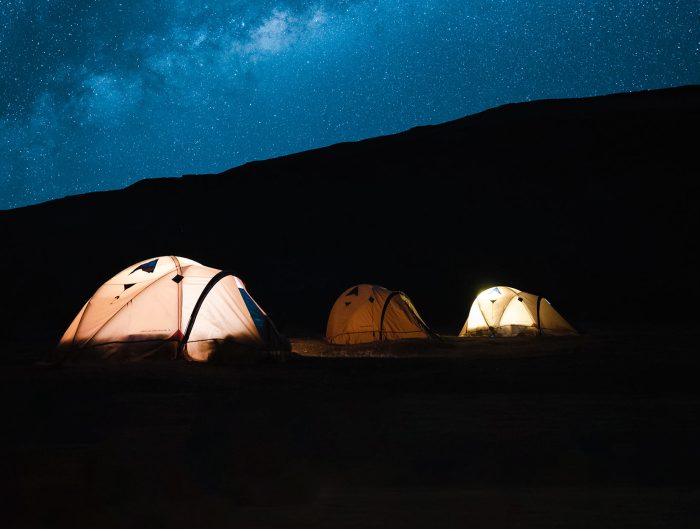









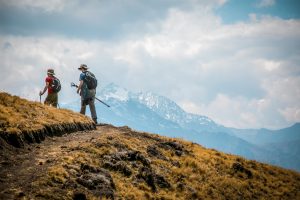


Leave A Reply